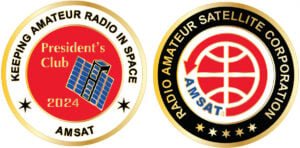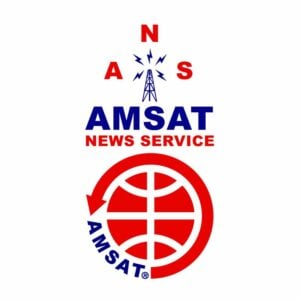
AMSAT News Service
ANS-035
February 4, 2024
In this edition:
- AO-92 Reenters Earth’s Atmosphere
- The First Amateur Radio Station on the Moon
- Lunar Excursion Vehicle (LEV-1) Amateur Telemetry Received
- AMSAT CubeSatSim Beta Release – v1.3
- VUCC & DXCC Satellite Standing as of February 1, 2024
- Changes to AMSAT-NA TLE Distribution for February 2, 2024
- Request to Reconsider Decommissioning of IO-117 Under Evaluation by Italian Space Agency
- ARISS News
- Upcoming Satellite Operations
- Hamfests, Conventions, Maker Faires, and Other Events
- Satellite Shorts From All Over
The AMSAT News Service bulletins are a free, weekly news and information service of AMSAT, The Radio Amateur Satellite Corporation. ANS publishes news related to Amateur Radio in Space including reports on the activities of a worldwide group of Amateur Radio operators who share an active interest in designing, building, launching and communicating through analog and digital Amateur Radio satellites.
The news feed on https://www.amsat.org publishes news of Amateur Radio in Space as soon as our volunteers can post it.
Please send any amateur satellite news or reports to: ans-editor [at] amsat.org
You can sign up for free e-mail delivery of the AMSAT News Service Bulletins via the ANS List; to join this list see: https://mailman.amsat.org/postorius/lists/ans.amsat.org/
AO-92 Reenters Earth’s Atmosphere
After just over six years in orbit, Fox-1D, designated as AMSAT-OSCAR 92 (AO–92), likely re-entered the Earth’s atmosphere on February 3, 2024 (Space-Track had not issued the final decay message as of the time of this writing.)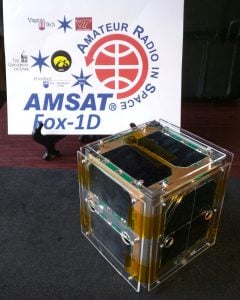
AO-92 was a 1U CubeSat developed and built by AMSAT. It carried a single-channel transponder for mode U/v in FM and also had an L-band converter (the AMSAT L-band downshifter experiment), which allowed the FM transponder to be switched to an uplink in the 23 cm band.
In addition to the transponders, the satellite carried the following scientific and technical payloads:
- High Energy Radiation CubeSat (HERCI) built by the University of Iowa
- Camera Experiment built by Virginia Tech
- MEMS GYRO Experiment built by Penn State-Erie
The satellite had a single whip antenna for the 70 cm and 23 cm bands (uplink), as well as an antenna for the 2m band (downlink).
AO-92 was launched on January 12, 2018 at 03:59 UTC on an Indian PSLV XL rocket, along with the main payloads Cartosat-2F, NovaSAR-S, and 31 other small satellites from the Satish Dhawan Space Center, India. At 05:17 UTC, the antennas were deployed over the North Pole and the satellite began to operate. At 05:28 UTC the first telemetry was received.
On the 03:25 UTC pass on January 26, 2018, AMSAT Vice President – Engineering Jerry Buxton, N0JY, announced that AO–92 had been commissioned and formally turned the satellite over to AMSAT Operations. AMSAT Vice President – Operations Drew Glasbrenner, KO4MA, then declared that AO–92 was open for amateur use.
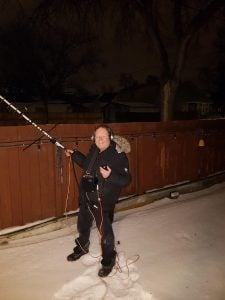
In addition to a very popular U/v transponder, the satellite provided a couple of unique capabilities. First was the L-band downshifter experiment, which was generally activated for 24 hours each Sunday while the satellite was able to support it. Pre-launch estimates suggested that approximately 100 watts ERP would be required to access the satellite, but much lower power outputs proved to be usable. Many stations operated through the satellite with radios such as the Alinco DJ-G7T at 1 watt of output into handheld antennas of between between 10 and 16 elements. At least one station reported accessing the satellite with just a simple whip antenna on 23 cm.
The camera, developed by students at Virginia Tech, also proved to be popular and delivered many good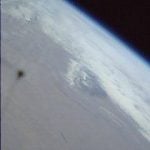 pictures, with the last photos received on September 19, 2020. An archive of all of the photos captured by ground stations can be found at https://www.amsat.org/tlm/showImages.php?id=4.
pictures, with the last photos received on September 19, 2020. An archive of all of the photos captured by ground stations can be found at https://www.amsat.org/tlm/showImages.php?id=4.
The distance record on AO-92’s U/v mode was 5,011 km – a transatlantic QSO between F4DXV and VE1VOX that took place on August 10, 2020. The record via the L/v mode was 4,202 km between OA4/XQ3SA and XE1MEX on June 3, 2020.
By early 2021, the aging NiCd cells – having been purchased in the early 2010s along with the rest of the Fox-1 battery cells – had degraded to the point where the satellite was entering safe mode on every eclipse. It was rarely operational in recent months. The transponder was occasionally turned on, but usually defaulted into “Safe Mode” at the next eclipse. The last telemetry frame was received from the satellite on October 27, 2023 at 01:36 UTC.
By every measure, AO–92 was a tremendously successful amateur radio satellite, providing educational and research benefits to AMSAT’s university partners, as well as providing several years of reliable FM communication for amateurs. Its useful life far exceeded the average operational lifespan for commercial or educational CubeSats.
[ANS thanks Joe Fitzgerald, KM1P, AMSAT Orbital Elements Manager, and Paul Stoetzer, N8HM, AMSAT Executive Vice President, for the above information]
The First Amateur Radio Station on the Moon
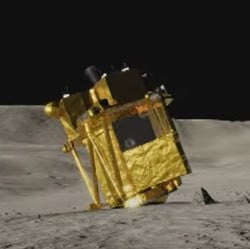
LEV-2 collects data while moving on the lunar surface, and LEV-1 receives the data.
The JAXA Ham Radio Club (JHRC), JQ1ZVI, secured amateur radio license JS1YMG for LEV-1, which has been transmitting Morse code on 437.41 MHz since January 19. The probe uses a 1 W UHF antenna with circular polarization and is transmitting “matters related to amateur business.”
Radio amateurs have been busy analyzing JS1YMG’s signal, with Daniel Estévez’s, EA4GPZ, blog introducing the method and extraction results for demodulating Morse code from the signal, as well as extracting the code string.
It’s unclear how long signals will be heard. JAXA has said that SLIM was not designed to survive a lunar night, which lasts about 14 days, and is due to return in a few days.
SLIM was launched on September 6, 2023, and landed on January 19, 2024, with the mission of analyzing the composition of rocks to aid research about the origin of the moon. SLIM’s landing made Japan the fifth country to achieve a soft touchdown on the moon. The landing was achieved with exceptional precision — within 180 feet of its targeted touchdown location.
[ANS thanks ARRL News for the above information]
The 2024 Coins Are Here Now!
Help Support GOLF and Fox Plus.
Join the AMSAT President’s Club today!
Lunar Excursion Vehicle (LEV–1) Amateur Telemetry Received
The Japan Aerospace Exploration Agency (JAXA) confirmed on January 20, 2024, that the Lunar Excursion Vehicle (LEV–1), a small robot deployed from the Smart Lander for Investigating Moon (SLIM), successfully conducted activities on the lunar surface. The telemetry data were sent directly from the small robot.
According to telemetry data, after deployment from SLIM, LEV–1 executed planned leaping movements and direct communication with ground stations, including inter-robot test radio wave data transmission from the Transformable Lunar Robot (LEV-2, nicknamed “SORA-Q”). On the other hand, image acquisition on the lunar surface has not been confirmed as of now.
Currently, LEV–1 has completed its planned operational period on the lunar surface, depleted its designated power, and is in a standby state on the lunar surface. While the capability to resume activity exists contingent on solar power generation from changes in the direction of the sun, efforts will be maintained to continue receiving signals from LEV–1.
Both LEV–1 and LEV-2 have become Japan’s first lunar exploration robots. Additionally, the small LEV–1 with a mass of 2.1 kg (including a 90g communication device), achieved successful direct communication with Earth from the moon. This is considered as the world’s smallest and lightest case of direct data transmission from approximately 380,000 kilometers away.
Furthermore, the accomplishment of LEV–1‘s leaping movements on the lunar surface, inter-robot communication between LEV–1 and LEV-2, and fully autonomous operations represent groundbreaking achievement. It would be regarded as a valuable technology demonstration for future lunar explorations, and the acquired knowledge and experience will be applied in upcoming missions.
Moreover, the transmission of UHF band radio waves from LEV–1 as part of outreach efforts has encouraged participation from amateur radio operators globally, and we have been receiving reports of successful signal receptions. This initiative provided an opportunity for the public to be directly engaged in lunar exploration missions. We would like to extend our sincere gratitude to everyone involved in the LEV–1 mission.
LEV–1 has an International Amateur Radio Union (IARU) coordinated downlink frequency of 437.410 MHz. A detailed report on receiving and decoding LEV–1 telemetry has been prepared by Daniel Estevez, EA4GPZ/M0HXM. It can be found at https://destevez.net/2024/01/
[ANS thanks the Japan Aerospace Exploration Agency (JAXA) and Daniel Estevez, EA4GPZ/M0HXM, for the above information]
AMSAT CubeSatSim Beta Release – v1.3
You might have heard about it or seen it at Hamvention or Symposium, but the official release of the new Beta CubeSatSim hardware and software is finally here!!
The new beta PCB board set v1.3 is shown in Figure 1, the new board stack is shown in Figure 2, and the new frame and solar panels is in Figure 3.
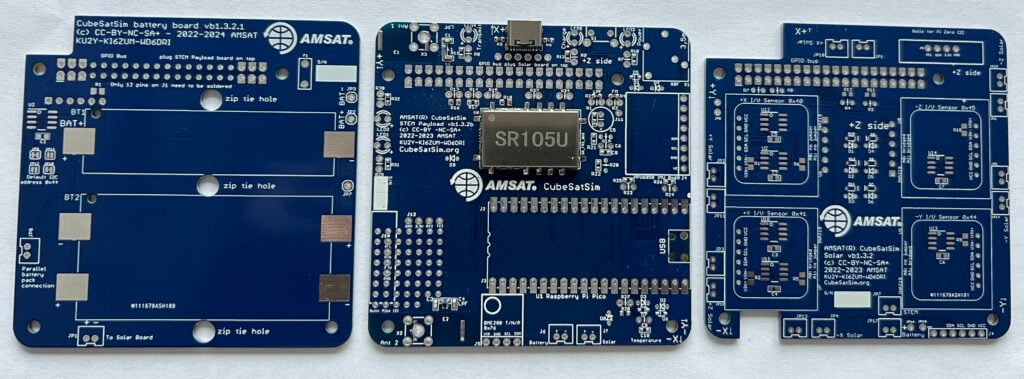
Figure 1. AMSAT CubeSatSim Beta PCB Board Set. From left to right, battery board, STEM Payload board, and Solar board (the replacement for the Main board)
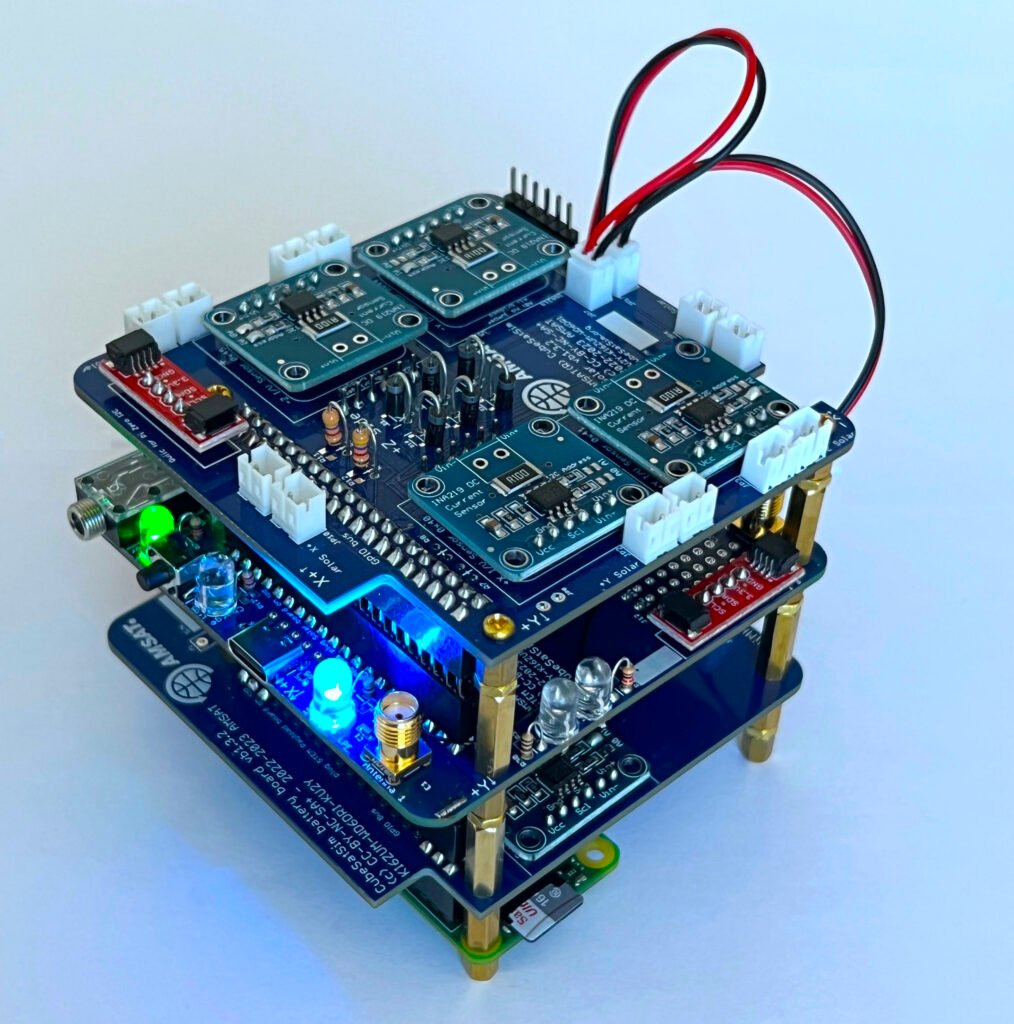
Figure 2. AMSAT CubeSatSim Beta Board Stack
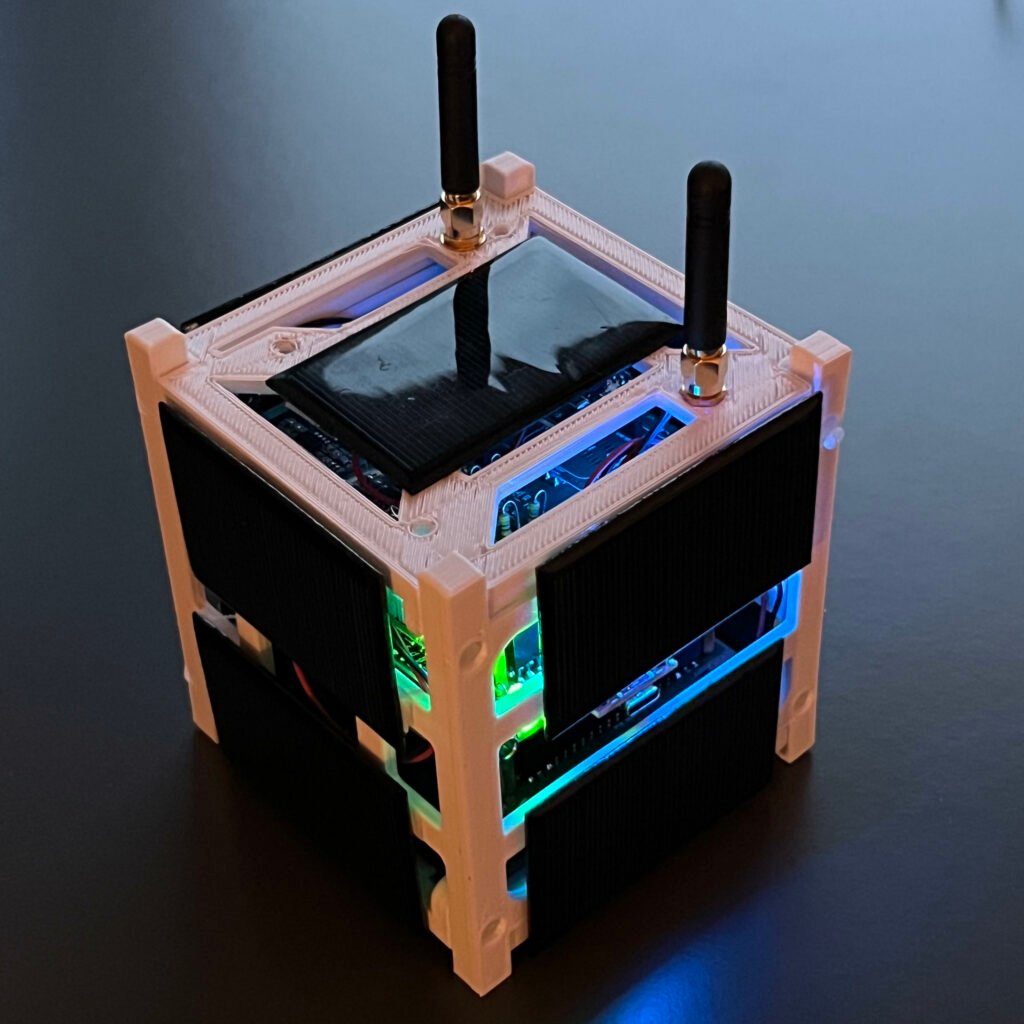
Figure 3. AMSAT CubSatSim Beta Frame and Solar Panels
Here are some links to information about the Beta release:
The software for the beta release is here: https://CubeSatSim.org/beta
The beta wiki instructions are here: https://CubeSatSim.org/wiki-
The beta Bill of Materials (BOM) is here: https://CubeSatSim.org/bom-
The beta hardware files are here: https://CubeSatSim.org/
The beta frame STL files for 3D printing are here: https://github.com/
Information about the latest beta software release is here: https://github.com/
The AMSAT CubeSatSim is a low-cost, fully functional open source model of a CubeSat nano-satellite. It has the following features:
- Working solar panels and rechargeable batteries
- Multi-channel voltage, current, and temperature telemetry transmitted in the Amateur Radio UHF band generated by a Raspberry Pi Zero single board computer
- Telemetry decoding using AMSAT’s FoxTelem software or APRS software
- STEM Payload board with Raspberry Pi Pico microcontroller with sensors
- Tape measure dipole or SMA antenna with integrated Low Pass Filter
- 3D printed frame
Here is a summary of the changes with the new beta hardware and software:
- New FM transceiver module for better frequency stability and simple command and control receiver to change telemetry modes using RF
- More modern and cheaper Raspberry Pi Pico micro controller on STEM Payload board
- Easily connect additional sensors for the Pico or Pi using the Qwiic connector system (https://www.sparkfun.com/
qwiic ) - SSTV camera images now display callsign and battery status overlay
- Can be modified to fly as a balloon payload with 500mW FM output for SSTV, APRS, or CW transmissions with software support on Pico for a serial GPS module
- Lower parts cost and easier to source. All parts can now be sourced from electronics distributors and Amazon including easy to find solar panels. New BOM uses Octopart electronic part inventory site with one click distributor ordering (https://CubeSatSim.org/bom-
beta) - Redesigned for blue INA219 voltage and current sensors instead of more expensive purple ones
- Battery board now has integrated voltage and current sensor
- Simpler electrical power system with no boost converter or charge control modules
- Kits can be built with through hole parts except for a few surface mount parts. Fully assembled boards will hopefully be available in the future using SMT parts
- Transmit and receive frequencies easily configurable from default 434.9 MHz and 435 MHz
During this beta period, we ask for your help in testing the new hardware and software and making sure that all the instructions and documentation are accurate. To help with this, I am pleased to announce that past purchasers of the CubeSatSim v1 PCB board sets are eligible for a free beta v1.3.2 set of PCB boards. Just email me ku2y at arrl.net! I will verify the order and ship you a new set of 3 blank boards. The boards will have the surface mount components already mounted. The first one hundred who contact me in the next three months will be eligible to receive them. For other orders, you will be able to choose between the v1 boards or the new beta v1.3.2 boards.
73,
Alan Johnston, PhD
KU2Y
AMSAT Vice President for Educational Relations
P.S. AMSAT has CubeSatSim Loaners available to ship to your event or presentation or STEM outreach activity – just contact me if you have an upcoming event email at ku2y at arrl.net or on social media at @[email protected]
[ANS thanks Alan Johnston, KU2Y, AMSAT Vice President – Educational Relations for the above information]
VUCC & DXCC Satellite Standing as of February 1, 2024
VUCC Satellite Award/Endorsement Change Summary
January 01, 2024 to February 01, 2024
| Call | 1-Jan | 1-Feb |
| WC7V | 1451 | 1457 |
| N8RO | 1401 | 1423 |
| W5CBF | 1224 | 1326 |
| DL5GAC | New | 1300 |
| DF2ET | 1102 | 1200 |
| KF7R | 1075 | 1100 |
| N0JE | 1075 | 1100 |
| N3GS | 986 | 1038 |
| OZ9AAR | 900 | 1000 |
| N8JCM | New | 917 |
| EA2AA | 875 | 883 |
| KQ4DO | 827 | 853 |
| W8LR | 825 | 841 |
| W2GDJ | 705 | 822 |
| FG8OJ | 737 | 801 |
| VU2LBW | 603 | 751 |
| WD9EWK (DM43) | 734 | 736 |
| JL1SAM | 601 | 700 |
| N8MR | 658 | 675 |
| AF5CC | 646 | 651 |
| JG6CDH | 553 | 605 |
| N6UTC | 551 | 600 |
| WB7VUF | 555 | 572 |
| N5EKO | 500 | 550 |
| N3CAL | 480 | 525 |
| F6GLJ | 400 | 501 |
| N7ZO | 350 | 501 |
| DL6KBG | 331 | 500 |
| SA0UNX | 362 | 463 |
| LA6OP | New | 458 |
| AD2DD | 356 | 403 |
| KF2T | 111 | 399 |
| N6PAZ | 350 | 369 |
| JH8RZJ | New | 328 |
| AG4W | 161 | 314 |
| JI5USJ | 236 | 301 |
| AA0MZ | 276 | 277 |
| NJ2DX | 100 | 260 |
| IK8YTA | 162 | 243 |
| N7GR | 205 | 226 |
| KR7LD | New | 211 |
| PY2YJ | 150 | 210 |
| WD9EWK (DM22) | 198 | 200 |
| WD9EWK (DM31) | 187 | 195 |
| IK0WRB | 123 | 174 |
| W0SX | New | 134 |
| WK7G | New | 118 |
| K7AXA | New | 104 |
| SP7JS | New | 104 |
| W6CZ | New | 103 |
| YO6OEV | New | 103 |
| BA7LVG | New | 100 |
Congratulations to the new VUCC holders!
W6CZ is first VUCC Satellite holder from DM07
W0SX is first VUCC Satellite holder from DM37
LA6OP is First VUCC Satellite holder from JP67
YO6OEV is First VUCC Satellite holder from KN26
SP7JS is First VUCC Satellite holder from KO00
BA7LVG is First VUCC Satellite holder from OL63
DXCC Satellite Award/Endorsement Change Summary
January 01, 2024 to February 01, 2024
| Call | 1-Jan | 1-Feb |
| HB9BZA | 158 | 188 |
| PS8ET | 160 | 178 |
| F4BKV | 150 | 171 |
| G4GIR | 163 | 167 |
| PA3FWP | 127 | 157 |
| EA2AA | 154 | 156 |
| I3BUI | 142 | 155 |
| AC4G | 151 | 152 |
| OZ9AAR | 125 | 151 |
| EA6VQ | 127 | 145 |
| HB9RYZ | 141 | 145 |
| IK4CIE | 133 | 143 |
| HB9GWJ | 129 | 134 |
| RA3DNC | 107 | 131 |
| W5CBF | 100 | 130 |
| DL2QB | 100 | 120 |
| LA0FA | 102 | 109 |
| N3GS | 100 | 108 |
| IK8YTA | New | 100 |
Congratulations to the new DXCC Satellite holders!
IK8YTA is first DXCC Satellite holder from JN70
[ANS thanks Jon Goering, N7AZ, for the above information]
Changes to AMSAT-NA TLE Distribution for February 2, 2024
Two Line Elements or TLEs, often referred to as Keplerian elements or keps in the amateur community, are the inputs to the SGP4 standard mathematical model of spacecraft orbits used by most amateur tracking programs. Weekly updates are completely adequate for most amateur satellites. TLE bulletin files are updated Thursday evenings around 2300 UTC, or more frequently if new high interest satellites are launched. More information may be found at https://www.amsat.org/keplerian-elements-resources/
This week there are no additions or deletions to the AMSAT TLE distribution.
[ANS thanks Joe Fitzgerald, KM1P, AMSAT Orbital Elements Manager, for the above information]
Need new satellite antennas?
Purchase an M2 LEO-Pack from the AMSAT Store!
When you purchase through AMSAT, a portion of the proceeds goes towards Keeping Amateur Radio in Space.

Request to Reconsider Decommissioning of IO-117 Under Evaluation by Italian Space Agency
On Thursday, January 25, 2024 S5Lab posted on X that the GreenCube (IO-117) Digipeater would be permanently deactivated on February 5th.
Designed and developed by students of Sapienza University of Rome, IO-117 is the first satellite to carry an amateur radio payload into a Medium Earth Orbit (MEO) of approximately 6,000 km.
The message from S5Lab read:
Dear Friends,
After one year and a half of operations, it is time to conclude the GreenCube operations with the planned de-commissioning activities. After the conclusion of the nominal experiment and with the digipeater payload active for more than one year, we will perform the passivation operations for the satellite.
The planned passivation operations will be executed on Monday, 5 February 2024, at 00:00 UTC. From that day, GreenCube will be completely passivated and the digipeater will be switched off for good.
We want to thank everyone that endorsed, supported or participated in the mission and the radio amateur community that enthusiastically became a true part of our project. We hope that GreenCube will somehow be part of your memories of radio amateurs, space engineering enthusiasts, and we hope to involve you soon in many more adventures.
Thanks once again for the unbelievable memories shared together… See you soon!
The GreenCube Team at S5Lab
That afternoon, AMSAT sent a letter to S5Lab expressing the organization’s desire to leverage our decades of experience and work with S5Lab, AMSAT Italia, other AMSAT organizations, and the amateur satellite community at large to overcome any obstacles, regulatory or otherwise, to keeping IO-117 in service for as long as possible. AMSAT-DL, AMSAT-F, and other amateur satellite organizations also expressed similar sentiments. Peter Goodhall, 2M0SQL, began a petition on change.org that garnered over 1,500 signatures from amateur radio operators around the world in one week.
On the afternoon of Friday, February 2, 2024, AMSAT Italia made the following announcement:
AMSAT Italia would like to inform the amateur community that its request to the Italian Space Agency, the owner of the GREENCUBE satellite, to reconsider its decision of decommissioning the satellite is under evaluation.
Waiting for its decision, IO-117 is still operational.
The GreenCube satellite was born as a scientific experiment placed in MEO orbit which successfully concluded its mission.
IO-117 is the HAM Radio part of the satellite consisting of a digipeter which was promoted by AMSAT Italia and coordinated by IARU-R1.
At the moment AMSAT Italia is committed to promoting the continuation of the mission for the HAM Radio part of Greencube.
AMSAT Italia BoD
During its lifetime, IO-117 has proved to be a popular resource, allowing amateurs all over the world to obtain ARRL’s Worked All States (WAS) and DX Century Club (DXCC) awards via satellite and to boost their VHF/UHF Century Club (VUCC) grid totals. A strong presence by Japanese amateurs has allowed many to work all the Japanese prefectures. A few DXpeditions, such as TX5S to Clipperton Island, have also brought gear for IO-117 along and provided rare DX entities via satellite. Multiple future DXpeditions also plan IO-117 activities. AMSAT is hopeful that the satellite’s lifetime can be extended.
[ANS thanks AMSAT-UK, AMSAT-DL, AMSAT-IT, AMSAT, Peter Goodhall, 2M0SQL, and S5Lab for the above information]
ARISS News
Amateurs and others around the world may listen in on contacts between amateurs operating in schools and allowing students to interact with astronauts and cosmonauts aboard the International Space Station. The downlink frequency on which to listen is 145.800 MHz worldwide.
Lilburn Elementary School, Lilburn, GA, direct via K4RGK
The ISS callsign is presently scheduled to be NA1SS
The scheduled crewmember is Jasmin Moghbeli KI5WSL
The ARISS mentor is K4RGK
Contact is go for: Wed 2024-02-07 14:24:10 UTC 57 deg
School of Telecommunications Engineering, ETSIT Valencia (Universitat Politecnica de Valencia), Valencia, Spain, direct via EA5RKP
The ISS callsign is presently scheduled to be OR4ISS
The scheduled crewmember is Loral O’Hara KI5TOM
The ARISS mentor is IKØUSO
Contact is go for: Fri 2024-02-09 08:12:46 UTC 31 deg
School TBD, Russia, direct via TBD
The ISS callsign is presently scheduled to be RSØISS
The scheduled crewmember is Nikolay Chub
The ARISS mentor is RV3DR
Contact is go for 2024-02-15 08:20 UTC
The Service Module radio is temporarily stowed.
As always, if there is an EVA, a docking, or an undocking; the ARISS radios are turned off as part of the safety protocol.
The crossband repeater continues to be active (145.990 MHz up {PL 67} & 437.800 MHz down), If any crewmember is so inclined, all they have to do is pick up the microphone, raise the volume up, and talk on the crossband repeater. So give a listen, you just never know.
Note, all times are approximate. It is recommended that you do your own orbital prediction or start listening about 10 minutes before the listed time.
The latest information on the operation mode can be found at https://www.ariss.org/current-status-of-iss-stations.html
The latest list of frequencies in use can be found at https://www.ariss.org/contact-the-iss.html
[ANS thanks Charlie Sufana, AJ9N, one of the ARISS operation team mentors for the above information]
Upcoming Satellite Operations
IO-117!!
JR5JAQ/6 will be QRV from PM53 and PM62 in Oita prefecture for a few days. He will also be active from PM62 in Miyazaki prefecture later in the week. Check hams.at for individual pass times.
JS3KKT/3 will be QRV from PM74 (prefecture unknown) just one day before the planned passivation of Greencube. Refer to hams.at for additional info.
A growing number of satellite rovers are currently engaged in sharing their grid square activations on https://hams.at. By visiting the website, you gain easy access to comprehensive information about the operators responsible for activating specific grid squares. Additionally, you have the ability to assess the match score between yourself and a particular rover for a given pass, while also being able to identify the upcoming satellite passes that are accessible from your location.
[ANS thanks Ian Parsons, K5ZM, AMSAT Rover Page Manager, for the above information]
Want to fly the colors on your own grid expedition?
Get an AMSAT car flag and other neat stuff from our Zazzle store!
25% of the purchase price of each product goes towards Keeping Amateur Radio in Space
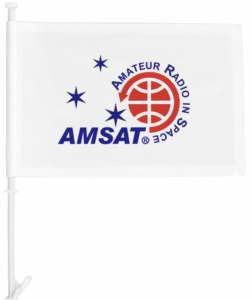
Hamfests, Conventions, Maker Faires, and Other Events
AMSAT Ambassadors provide presentations, demonstrate communicating through amateur satellites, and host information tables at club meetings, hamfests, conventions, maker faires, and other events.
AMSAT Ambassador Clint Bradford, K6LCS, says,
“Think a 75-minute presentation on “working the easy satellites” would be appropriate for your club or event? Let me know by emailing me at k6lcsclint (at) gmail (dot) com or calling me at 909-999-SATS (7287)!”
Clint has NEVER given the exact same show twice: EACH of the 150+ presentations so far has been customized/tailored to their audiences.
Scheduled Events
Orlando HamCation 2024
Friday February 9th through Sunday February 11th, 2024
Central Florida Fairgrounds and Expo Park
4603 West Colonial Drive
Orlando, Florida 32808
https://www.hamcation.com
40th Anniversary Celebration of the Positive Impact of Amateur Radio on Human Spaceflight
Thursday February 22nd through Saturday February 24th, 2024
Center for Space Education: Astronauts Memorial Foundation
Kennedy Space Center, M6-306 405 State Road, FL 32899
https://www.ariss.org/overview.html
2024 CubeSat Developer’s Workshop
April 23-25, 2024
San Luis Obispo, CA
https://www.cubesatdw.org/
Dayton Hamvention 2024
Friday May 17th through Sunday May 19th, 2024
Greene County Fairgrounds and Expo Center
120 Fairground Road
Xenia, OH 45385
https://hamvention.org
[ANS thanks Clint Bradford, K6LCS, and AMSAT for the above information]
Satellite Shorts from All Over
+ NASA announced the crew assignments on January 31 for the SpaceX Crew-9 mission to the International Space Station. They will join Expedition 71 and 72 crew members no earlier than August, and will arrive at the space station for a short duration handover with NASA’s SpaceX Crew-8. Launching aboard the Dragon spacecraft will be NASA astronauts Commander Zena Cardman, Pilot Nick Hague, KG5TMV, and Mission Specialist Stephanie Wilson, KD5DZE, and Roscosmos cosmonaut Mission Specialist Aleksandr Gorbunov. The four crew members are preparing to conduct a wide-ranging set of operational and research activities, including ARISS contacts. (ANS thanks NASA for the above information)
+ After more than 3 years in orbit, AO-109 remains operational and usable for QSOs using modes such as FT4 despite extremely low power output. SSB QSOs are also possible with high gain receive antennas. Due to a failed final power amplifier transistor, the total output power of AO-109 is approximately 8 mW.
+ YouTube channel Ham Radio Crash Course has featured IO-117 in two recent videos. https://www.youtube.com/watch?v=FjW3XOKCmBo and https://www.youtube.com/watch?v=mn_qPVoue3A
Join AMSAT today at https://launch.amsat.org/
In addition to regular membership, AMSAT offers membership to:
- Societies (a recognized group, clubs or organization).
- Primary and secondary school students are eligible for membership at one-half the standard yearly rate.
- Post-secondary school students enrolled in at least half time status shall be eligible for the student rate for a maximum of 6 post-secondary years in this status.
- Memberships are available for annual and lifetime terms.
Contact info [at] amsat.org for additional membership information.
73 and remember to help Keep Amateur Radio in Space!
This week’s ANS Editor,
Paul Stoetzer, N8HM
n8hm [at] amsat.org
ANS is a service of AMSAT, the Radio Amateur Satellite Corporation, 712 H Street NE, Suite 1653, Washington, DC 20002

